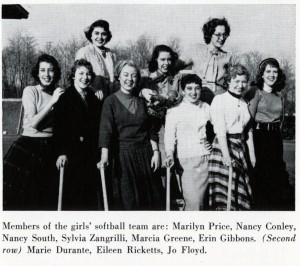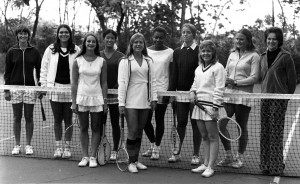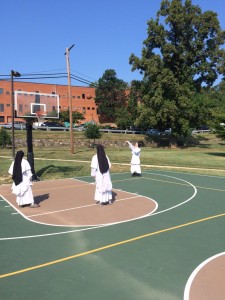
In the past year, our blog has highlighted the rich history of sports at CUA – the triumphs, challenges, and legends. But virtually all this coverage has focused on the men. Where are the women athletes? This absence highlights the relatively late start of women’s sports programs in American colleges. For the story of the female cardinals, when compared to their male counterparts, had its own unique challenges to overcome. And, despite its more recent origins, the history of women athletes at CUA is a fascinating tale of dedication and perseverance – qualities necessary for any athlete.
Until 1950, female undergraduates attending classes at CUA were not officially enrolled through the University, but rather were technically students of the Catholic Sisters College or Trinity College. Thus, it may come as little surprise that there is hardly a mention in our records of women athletes prior to the 1950s. Indeed, throughout the 1950s, women’s athletics at CUA largely consisted of the cheerleading squad and the occasional intramural competition between the resident sororities. By 1959, a women’s sports department was established, which offered dance instruction and ping-pong and badminton tournaments. Though women’s access to the athletic facilities was largely limited to two 90-minute blocks on Monday and Wednesday evenings.

The University hired its first coordinator of women’s sports in 1961, Jone Rastapkeviciuspage 20. Known to generations of CUA athletes as one of the Coach Dowds – having married fellow CUA coach Martin Dowd – Jone would work to build women’s athletics at CUA over the next 50 years. In order to invigorate the fledging program, Dowd sought to turn many of the intramural sports into “extramural” by connecting with nearby colleges. Together with Trinity College, Georgetown, American University, and George Washington University, CUA formed the Metropolitan Sports Association for Women (MISAW). MISAW operated throughout the mid-1960s and early 1970s.

The biggest challenge and opportunity that these emerging athletic programs faced came in the mid-1970s, with the passage of Title IX. With its enactment in 1975, educational institutions which received federal funding were required to provide equal access to housing, education, and extracurricular activities to all students regardless of sex. Despite financial limitations, institutional resistance, and doubt in some circles over the level of interest in sports among women, by the 1980s, CUA was home to a variety of intercollegiate women’s teams. As the years passed, the number of sports available to women has continued to grow: Tennis, volleyball, field hockey, softball, swimming, track and field, basketball, and more.
